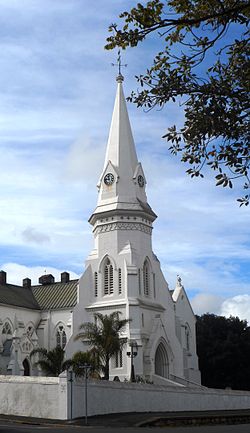Malmesbury, South Africa
| Malmesbury | |
|---|---|

The Dutch Reformed Church in Malmesbury
|
|
|
|
|
| Coordinates: 33°27′S 18°44′E / 33.450°S 18.733°ECoordinates: 33°27′S 18°44′E / 33.450°S 18.733°E | |
| Country | South Africa |
| Province | Western Cape |
| District | West Coast |
| Municipality | Swartland |
| Established | 1745 |
| Area | |
| • Total | 18.8 km2 (7.3 sq mi) |
| Population (2011) | |
| • Total | 35,897 |
| • Density | 1,900/km2 (4,900/sq mi) |
| Racial makeup (2011) | |
| • Black African | 24.9% |
| • Coloured | 55.3% |
| • Indian/Asian | 0.5% |
| • White | 18.4% |
| • Other | 0.9% |
| First languages (2011) | |
| • Afrikaans | 73.9% |
| • Xhosa | 16.3% |
| • English | 3.8% |
| • Sotho | 3.1% |
| • Other | 2.8% |
| Postal code (street) | 7300 |
| PO box | 7299 |
| Area code | 022 |
Malmesbury is a town of approximately 36,000 inhabitants in the Western Cape province of South Africa, about 65 km north of Cape Town.
The town is the largest in the Swartland (‘black land’) which took its name from the Renosterbos ('rhino bush'), an indigenous plant that turns black in the warm, dry summers. The area is especially known for its grain and wine cultivation as well as sheep and poultry farming.
Malmesbury was named after Sir Lowry Cole's father-in-law, the Earl of Malmesbury. Settlers were encouraged to make their homes here because of a tepid sulphur chloride mineral spring that was renowned for curing rheumatism. The first farms were allocated in 1703. When the fifth Dutch Reformed congregation in the Cape was established here, it became known as Zwartlands-kerk (Swartland Church) but was renamed Malmesbury in 1829. The town acquired municipal status in 1860. In 1911 the Encyclopædia Britannica recorded the population of the town at 3811 [1], however this may refer to a white population, as a census of 1849 recorded a total of 8520 residents. [2]
The town no longer attracts the ailing because this aspect was never developed by the local authority, and today a shopping centre is located on top of the site with only a decorative fountain marking the location of the original spring.
The following statistics describing Malmesbury are from the 2011 census.
Municipality — Malmesbury was a municipality in its own right from 1860 to 2000. By 1931, the council had adopted an emblem depicting a plough in front of a sheaf of wheat, surrounded by a buckled strap inscribed Deo frumentoque vires. This device was depicted on a cigarette card issued in 1931.
...
Wikipedia



